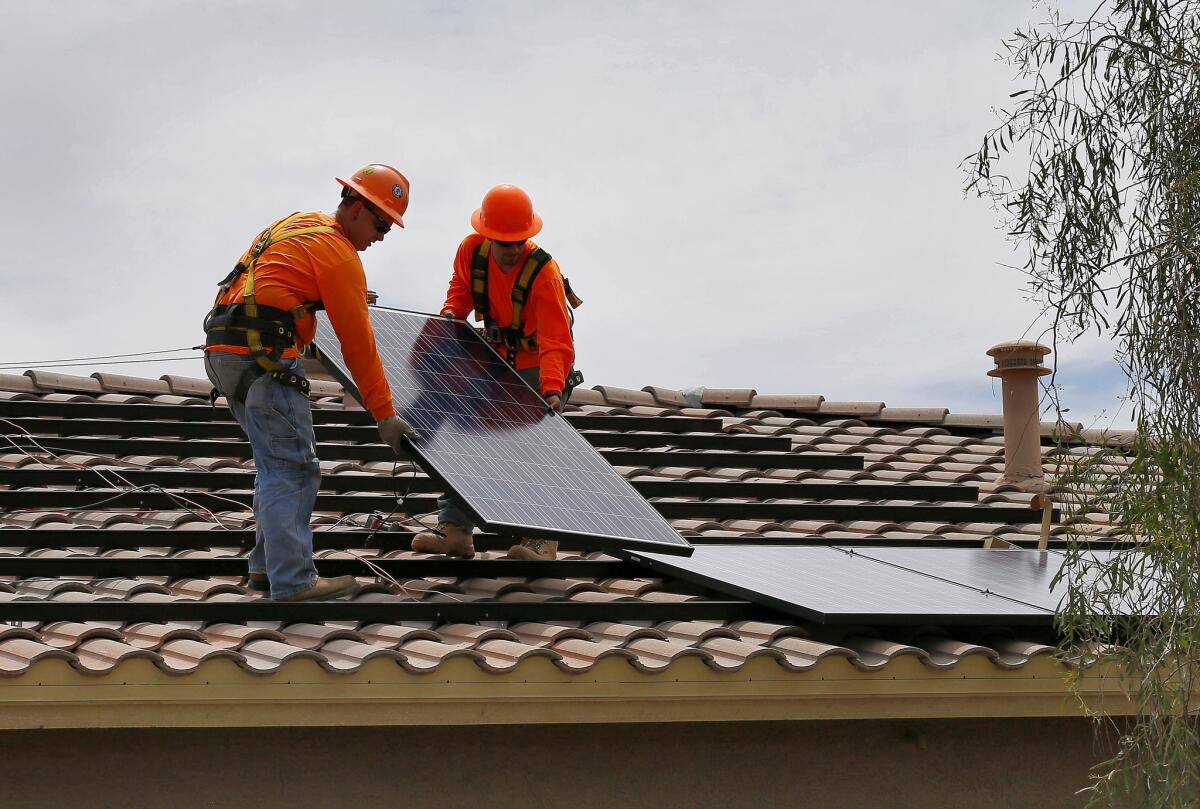Editorial: Please, PUC, don’t cast a cloud over the solar boom

Currently, solar-producing households can receive monetary credit for surplus power their systems contribute to the grid, a process called “net metering.”
- Share via
Southern California, the land of sunny days and houses as far as the eye can see, is particularly suited to take advantage of rooftop solar.
And though solar was slow to take off, it is sizzling now, thanks to government incentives and subsidies to offset the steep installation costs. Almost 400,000 California homes have solar panels on their roofs, turning the rays of the sun into kilowatts to run toasters and TVs.
Excess sun power — that is, the power generated by a solar-equipped household but not used by that household — goes back into the great electric grid that feeds the rest of us. Solar-producing households get monetary credit for every kilowatt they contribute to the grid. It’s a generous arrangement that, along with a 30% federal tax credit (which expires next year), has made it affordable even for people who aren’t Ed Begley Jr. to embrace the solar revolution.
We agree that a rebalancing of costs is necessary. But commissioners must tread carefully so as not to cast a cloud over the solar boom.
Unfortunately, it’s too generous to sustain as the industry expands rapidly, leaving fewer non-solar users to cover the cost of the subsidies and incentives. That’s why the California Public Utilities Commission has been tasked by lawmakers with adopting new rules by the end of the year for “net metering” — the credit users get for their excess energy — that are fairer and better reflect the true costs of providing energy.
A rebalancing of costs is necessary. But commissioners must tread carefully so as not to cast a cloud over the solar boom.
Since solar rooftop homes can’t generate power at night, most draw power from the electric grid when the sun goes down. So they also get an electric bill, though offset by the credit for the power they contribute. The investment in rooftop solar systems typically pays off in about seven years.
The PUC has received net metering proposals from a number of stakeholders. Some would drive up costs so dramatically for solar power users — we’re looking at you, Southern California Edison — it would be like turning out the lights on residential solar. Others that seek virtually no change just aren’t realistic. (The new rules would not apply to current solar customers until 20 years after the date of installation, and wouldn’t apply to L.A. Department of Water and Power customers at all.)
Commissioners must seek the middle ground. A proposal by the PUC’S Office of Ratepayer Advocates is a good place to start. It would keep the current buyback arrangement for surplus energy but add a modest fixed monthly fee for solar customers for the next 10 years (about $10 a month for the average rooftop system), which would increase for new solar customers as the industry expanded and pushed down installation costs.
What the PUC must not do is look only at the bottom line. Solar provides economic value to users, of course, but it also provides an incalculable benefit to all of us by reducing reliance on climate changing fossil fuels. It wouldn’t be wise to put this green energy out of reach to homeowners.
Follow the Opinion section on Twitter @latimesopinion and Facebook
More to Read
A cure for the common opinion
Get thought-provoking perspectives with our weekly newsletter.
You may occasionally receive promotional content from the Los Angeles Times.









